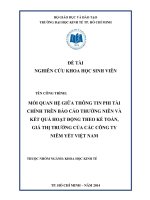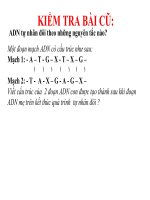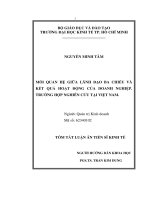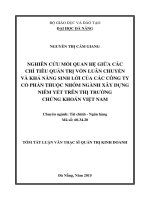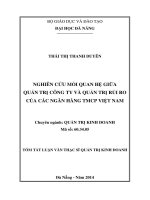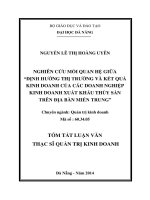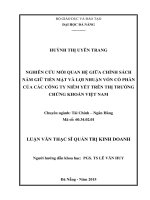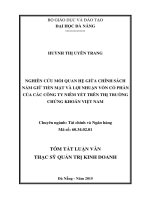Tác động trung gian của kế toán quản trị chiến lược trong mối quan hệ giữa vốn trí tuệ và kết quả hoạt động của doanh nghiệp – bằng chứng tại việt nam tt tiếng anh
Bạn đang xem bản rút gọn của tài liệu. Xem và tải ngay bản đầy đủ của tài liệu tại đây (986.87 KB, 50 trang )
MINISTRY OF EDUCATION AND TRAINING
UNIVERSITY OF ECONOMICS, HO CHI MINH CITY
-------------------------------TRINH HIEP THIEN
Mediating effect of strategic management
accounting practices in the relationship between
intellectual capital and corporate performance
Evidence from Vietnam
A summary of dissertation submitted for the Degree of
Doctor of Philosophy in Accounting
Code: 9.34.03.01
October 2018
MEDIATING EFFECT OF STRATEGIC
MANAGEMENT ACCOUNTING PRACTICES IN THE
RELATIONSHIP BETWEEN INTELLECTUAL
CAPITAL AND CORPORATE PERFORMANCE
EVIDENCE FROM VIETNAM
Trinh Hiep Thien
MPAcc (University of Sydney), MBA (UEH), BBus (UEH)
A summary of dissertation submitted for the Degree of
Doctor of Philosophy in Accounting
Code: 9.34.03.01
Academic Supervisors:
Dr. Doan Ngoc Que
Dr. Le Dinh Truc
University of Economics, Ho Chi Minh City
October 2018
–1–
INTRODUCTION
1. Background
It is often argued that organizations in today’s knowledge-based
economy do not only initially invest in physical assets, nevertheless in
intangibles, as these are but also today’s value drivers (Mehralian,
Rasekh, Akhavan, & Ghatari, 2013). Amongst these intangible assets,
IC plays a key role, and its management becomes a critical issue given
the direct and indirect advantages.
i
i
i
i
i
i
i
i
i
i
i
i
i
i
i
i
i
i
i
i
i
i
i
i
i
i
i
i
i
i
i
i
i
i
i
i
i
i
i
i
i
i
i
i
i
i
i
i
i
i
i
i
i
i
i
i
When analysing the Vietnamese transitional economic context,
Vietnamese enterprises have gradually applied the advanced accounting
techniques, in line with market mechanisms because many wholly
foreign-owned enterprises established in Vietnam have been providing
practical knowledge of strategic management accounting, which has
been introduced to Vietnamese practitioners and scholars. Therefore, it
is inappropriate to state that medium and large enterprises in Vietnam
do not have any understanding of how to implement strategic
management accounting in their business operations. Not surprisingly,
the issue of strategic management accounting thereby started to be
studied in Vietnam since the 2010s. Based on all above arguments, the
author believes the necessity of studying the correlation between
intellectual capital, strategic management accounting practices and
corporate performance in the case study of Vietnam. Vietnamese
business environment will provide enough information about intellectual
capital as well as strategic management accounting practices that support
such research endeavours.
i
i
i
i
i
i
i
i
i
i
i
i
i
i
i
i
i
i
i
i
i
i
i
i
i
i
i
i
i
i
i
i
i
i
i
i
i
i
i
i
i
i
i
i
i
i
i
i
i
i
i
i
i
i
i
i
i
i
i
i
i
i
i
i
i
i
i
i
i
i
i
i
i
i
i
i
i
i
i
i
i
i
i
i
i
i
i
i
i
i
i
i
i
i
i
i
i
i
i
i
i
i
i
i
i
i
i
i
i
i
i
i
i
i
i
i
i
i
i
i
i
i
i
2. Research questions and research objectives
Three research questions have been proposed:
Research question 1: What is the direct effect of intellectual capital
components on corporate performance in Vietnamese enterprises?
–2–
Research question 2: What is the effect of intellectual capital
components on corporate performance in the presence of strategic
management accounting practices?
Research question 3: How do SMA practices handle each
component of IC to improve corporate performance?
Overall research objective:
The overall research objective of this dissertation is to investigate
the mediating effect of SMA practices on the relationship among IC
components and three financial dimensions of corporate performance. It
also empirically analyses the role of SMA practices playing the
management of IC components.
Specific research objectives:
- RO1: Testing the direct impact of each of intellectual capital
components on corporate performance.
i
i
i
i
i
i
i
i
i
i
i
i
i
- RO2: Examining the direct influence of strategic management
accounting practices over corporate performance.
i
i
i
i
i
i
i
i
i
i
i
i
- RO3: Investigating an indirect path between intellectual capital
components and corporate performance through the mediating
role of strategic management accounting practices.
i
i
i
i
i
i
i
i
i
i
i
i
i
i
i
i
i
i
i
i
- RO4: Empirically analysing which group of strategic
management accounting practices are related to manage which
components of intellectual capital.
i
i
i
i
i
i
i
i
i
i
i
i
i
i
i
i
i
i
- RO5: Providing additional evidence on the interconnection of
intellectual capital components.
i
i
i
i
i
i
i
i
i
i
3. Research object and research scope
The research object of this dissertation is the relationship among IC,
SMA practices and corporate performance. To investigate SMA practices
applied in a business organization, the data is collected through
questionnaire survey which is sent to SMA practitioners. Moreover, the
–3–
unit of observation is also financial information in annual reports or
financial statement reports which draw financial data on IC and corporate
performance.
The scope of this study is limited in three aspects. Firstly, this study
selects Vietnam. Secondly, the observed business organizations are
enterprises listed on Hochiminh Stock Exchange (HoSE) and Hanoi Stock
Exchange (HNX). Thirdly, since the survey related to SMA practices is
conduct in the year of 2016, this study only uses 2016 financial information
about IC and financial performance of the public companies.
4. Methodology
This study mainly uses quantitative research method by using
empirical survey data and financial data obtained from a sample of at
least 127 public enterprises in Vietnam for the year of 2016. Data analysis
is conducted by applying partial least squares structural equation
modelling (PLS-SEM) with the support of SPSS 24.0 and SmartPLS 3.1
software packages.
i
i
i
i
i
i
i
i
i
i
i
i
i
i
i
i
i
i
i
i
i
i
i
i
i
i
i
i
i
i
i
i
i
i
i
i
i
i
i
i
i
i
i
i
i
i
i
i
i
i
i
i
i
i
i
i
5. Outline of the dissertation
Besides the parts of introduction and conclusion, this dissertation is
organized with 7 chapters, as follows:
Introduction part.
Chapter 1: Literature review.
Chapter 2: The concepts and intellectual capital measurement models.
Chapter 3: Theoretical framework and hypotheses development.
Chapter 4: Research methodology.
Chapter 5: Sample characteristics and measurement scales assessment.
Chapter 6: Data analysis and discussion.
Chapter 7: Implications for managing IC by SMA practices.
Conclusion part.
–4–
CHAPTER 1: LITERATURE REVIEW
1.1. Review of international studies of intellectual capital
1.1.1. Stages in developing intellectual capital (IC) as a research field
Petty and Guthrie (2000) also outlined two stages in researching
IC. The first-stage (prior the mid-1990s) efforts typically focused on
raising awareness as to why recognizing and understanding the potential
of IC towards creating and managing sustainable competitive advantages
is extremely essential (Petty & Guthrie, 2000). The second stage of IC
research gathered further evidence, at an organizational level, focusing on
the how of IC capital and labour market reacted towards the potential for
IC to create value (Petty & Guthrie, 2000). According to Dumay, Guthrie,
and Ricceri (2012) a third stage of IC research is emerging and thirdstage IC research focuses on considering value from IC is not just
monetary but incorporates worth and importance of the products and
services to customers and other stakeholders (Dumay & Garanina, 2013).
i
i
i
i
i
i
i
i
i
i
i
i
i
i
i
i
i
i
i
i
i
i
i
i
i
i
i
i
i
i
i
i
i
i
i
i
i
i
i
i
i
i
i
i
i
i
i
i
i
i
i
i
i
i
i
i
i
i
i
i
i
i
i
i
i
i
i
i
i
i
i
i
i
i
i
i
i
i
i
i
i
i
i
i
i
i
i
i
i
i
i
i
i
i
i
i
i
i
i
i
i
i
i
i
i
i
i
i
i
i
i
i
i
i
i
i
i
i
i
i
i
i
i
i
i
i
1.1.2. Research trends on IC in the accounting discipline
The issue of IC is studied in four perspectives, such as economic,
strategic, managerial and accounting perspective (Alcaniz, GomezBezares, & Roslender, 2011). In the accounting discipline, as illustrated in
Dumay et al. (2012)’s paper examining 423 journal papers in terms of IC
during the period from 2000 to 2009, the popular focus of IC accounting
research is management accounting and external reporting but little has
been published about accountability, governance and auditing.
i
i
i
i
i
i
i
i
i
i
i
i
i
i
i
i
i
i
i
i
i
i
1.1.3. Research methods used to study intellectual capital
There are five groups of research methods found. It indicates that
commentary/ normative/ policy is the most commonly used, followed by
survey/ questionnaire and next to case study/ interviews. Dumay et al.
(2012) highlight that the trend over the last 10 years is a steady increase
in empirical work, while normative work has declined.
i
i
i
i
i
i
i
i
i
i
i
i
i
i
i
i
i
i
i
i
i
i
i
i
i
i
i
i
i
i
i
i
i
i
i
i
i
i
i
i
i
i
i
i
i
i
i
i
i
i
i
i
i
–5–
1.1.4. Review of studies investigating the relationship between
intellectual capital and corporate performance
There are numerous pieces of research in many countries, affirming
this correlation between IC and corporate performance undertaken by a
variety of research methods. One quantifiable and obtainable measure for
IC is the VAIC, developed by Public (2000). Overall, studies using VAIC
as measures of IC components have resulted in a mixture of outcomes
across different countries, industries and years. A range of inconsistent
evidence do not result in a compelling conclusion regarding the
correlation between IC and corporate performance.
i
i
i
i
i
i
i
i
i
i
i
i
i
i
i
i
i
i
i
i
i
i
i
i
i
i
i
i
i
i
i
i
i
i
i
i
i
i
i
i
i
1.2. Review of international studies of SMA
Since Simmonds’ first definition was introduced over 30 years ago,
there is little agreement what is and what constitutes SMA. Overall, the
research continues to maintain four themes emphasizing on (1) how to
define the concept of SMA, (2) what kinds of SMA techniques applied in
a variety of industries, countries, (3) the impacts of strategy options on
SMA changes and (4) strategic management accounting process. Most of
the published empirical research over the past 30 years has consisted of
questionnaire surveys that sought to establish the extent to which specific
SMA techniques have been adopted (Langfield-Smith, 2008).
i
i
i
i
i
i
i
i
i
i
i
i
i
i
i
i
i
i
i
i
i
i
i
i
i
i
i
i
i
1.3. Review of studies of intellectual capital and strategic
management accounting in Vietnam
1.3.1. Vietnamese context
The emergence of a private sector, the development of securities
markets and participation in international trading have positioned
Vietnam as one of the world’s growing economies. Although there are
many “incremental” or “big bang” changes in Vietnamese overall
organizations, including listed companies, during Vietnam’s progress of
international integration, these have not actually measured or valued their
i
i
i
i
i
i
i
i
i
i
i
i
i
i
i
i
i
i
i
i
i
i
i
i
i
–6–
IC (i.e. human resources capital, structural capital, relational capital) which
are generated in the past and after the impacts due to competitive pressures.
1.3.2. Research on intellectual capital in Vietnam
The empirical studies on IC have been conducted in many countries,
including but not to limited to, North America (Bontis, 1998; RiahiBelkaoui, 2003), South Africa (Firer & Mitchell-Williams, 2003),
Australia (Dumay, 2009), China (J. Chen, Zhu, & Hong Yuan, 2004) and
conducted in many Asian countries such as Malaysian (Bontis, Chua
Chong Keow, & Richardson, 2000), Taiwan (Ming-Chin, Shu-Ju, &
Hwang, 2005), Singapore (Hong Pew, Plowman, & Hancock, 2007), Thai
(Saengchan, 2008). Vietnamese firms are in developing various aspects of
IC, thus the need for more research in this area is evident.
1.3.3. Research on strategic management accounting in Vietnam
Since Vietnam adopted an open-door policy, the level of
competition in the economy has been increasing significantly for most
Vietnamese enterprises, because many privates, joint ventures and the
wholly foreign-owned enterprises have been established in Vietnam during
the last two decades (Anh, 2010). Therefore, the foreign organizations
bring practical knowledge of SMA introduced to Vietnamese practitioners
and scholars. Not surprisingly, hence, the issue of SMA started to be
studied in Vietnam since the 2010s; however, there has been little
systematic documentation and analysis of recent efforts to the use of
strategic management accounting practices in Vietnamese enterprises.
1.4. Research gaps
This study has identified three major research gaps: (1) lack of
studies concerning performance implication of IC in association with the
mediating role of strategic management accounting practices, (2) lack of
empirical research concerning the relationship between IC and each
group of SMA practices, and (3) lack of Vietnam empirical studies on IC
and SMA practices.
i
i
i
i
i
i
i
i
i
i
i
i
i
i
i
i
i
i
i
i
i
i
i
i
i
i
i
i
i
i
i
i
i
i
i
i
i
i
i
i
i
i
i
i
i
i
i
i
i
i
i
i
i
i
i
–7–
CHAPTER 2: THE CONCEPTS AND
INTELLECTUAL CAPITAL MEASUREMENT
MODELS
2.1. Definition of intellectual capital
Although IC has been defined from different perspectives, the only
common aspect in the definition of IC is related to the fact that strategic
intangible resources including information and knowledge are identified
and managed to acquire competitive advantages and a sustainable creation
of value with the aim of adding value to defined key stakeholders. As for
the components of the IC, it seems that there is a broad consensus about
the existence of three primary interrelated non-financial components
including human capital, structural (internal) capital and relational
(external) capital.
i
i
i
i
i
i
i
i
i
i
i
i
i
i
i
i
i
i
i
i
i
i
i
i
i
i
i
i
i
i
i
i
i
2.2. Components of intellectual capital
2.2.1. Human capital
According to McGregor, Tweed, and Pech (2004), human capital is
more broader meanings than human resource in term of the business
workforce and the more specific requirements of individual competence
in the form of knowledge, skills, the innovativeness and talents of
employees. Furthermore, Barney (1991a) expands the definition of
human capital to include training, judgment, relationships and insights of
individuals and those representing the tacit knowledge embedded in the
mind of employees (Bontis & Fitz-enz, 2002).
i
i
i
i
i
i
i
i
i
i
i
i
i
i
i
i
i
i
i
i
i
i
i
i
i
i
i
i
i
i
i
i
i
i
i
i
i
i
i
i
i
i
i
i
i
i
i
i
i
i
i
i
i
i
i
i
i
i
i
i
i
i
i
i
i
i
i
i
i
i
i
2.2.2. Structural capital
Bontis (2001) defines structural capital as the hardwares, softwares,
databases, organization structure, patents, trademarks and everything else
that employees use to support their business and processes. The essence
of structural capital concentrates on “the knowledge infrastructure
embedded within the routines of an organization” (Bontis, 2001) including
i
i
i
i
i
i
i
i
i
i
i
i
i
i
i
i
i
i
i
i
i
i
i
i
i
–8–
technological components and architectural competencies. Referred to as
knowledge infrastructure in Gold and Arvind Malhotra (2001), it consists
of organizational structure, culture and technology. Furthermore, structural
capital refers to the learning and knowledge enacted in day-to-day
activities (Bontis, Bart, & Kong, 2007). This means that the pool of
knowledge remaining in an organization after employees have left the
workplace represents the fundamental core of structural capital
(Mouritsen, Nikolaj, & Marr, 2004; Nazari, 2010; Wang, 2011).
i
i
i
i
i
i
i
i
i
i
i
i
i
i
i
i
i
i
i
i
i
i
i
2.2.3. Relational capital
Relational capital is a suitable terminology to represent all
organization’s relations with external stakeholders (Bontis & Fitz-enz,
2002; Helm Stevens, 2011; Levy, 2009; Mouritsen et al., 2004).
Relational capital expands the concept of “client or customer capital” to
include all the external relationships of the firm (e.g. suppliers, allies,
trade unions, etc.). This capital includes relationships with external
stakeholders, networks with suppliers, distributors, lobby organizations,
partners, customer relationships (image building, loyalty, network
partners and investors) and branding (attitude, preference, reputation,
brand recognition) (Sydler, Haefliger, & Pruksa, 2014). Generally, María
Viedma Marti (2001) defines relational capital as the ability of an
organization to interact positively with business community members to
motivate the potential for wealth creation by enhancing human and
structural capital.
i
i
i
i
i
i
i
i
i
i
i
i
i
i
i
i
i
i
i
i
i
i
i
i
i
i
i
i
i
i
i
i
i
i
i
i
i
i
i
i
i
i
i
i
i
i
i
i
i
i
i
i
i
i
i
i
i
i
i
i
i
i
i
i
i
i
i
i
i
i
i
i
i
i
i
i
i
i
i
i
i
i
i
i
i
i
i
i
i
i
i
i
i
i
i
i
i
i
i
i
i
i
i
i
i
i
i
i
i
i
i
i
i
i
i
i
i
i
i
i
2.3. Definition of corporate performance
Dorestani (2009) defines corporate performance as a set of measures
focusing on factors that are most critical for the success of the organization,
including both financial and non-financial information. However, this
study limits research scope focusing on financial information as a set of
criteria to measure corporate performance.
–9–
Figure 2.1. Four-stage model of corporate market valuation
2.4. Determinants of SMA practices
In the 1990s, a substantial number of other researchers worked and
to define the concept of strategic management accounting, e.g. Bromwich
(1990); Ward (1992); Dixon and Smith (1993); Foster and Gupta (1994);
Guilding, Craven, and Tayles (2000); (Cinquini & Tenucci, 2010).
Although their definition and description of SMA differ considerably,
three typical characteristics of SMA can be drawn from their writings:
i
i
i
i
i
i
i
i
i
i
i
i
i
i
i
i
i
i
i
i
i
i
i
i
i
i
i
i
i
i
i
i
i
i
i
i
i
i
i
i
i
i
i
i
i
i
i
i
i
i
i
i
i
i
i
i
i
i
i
i
-
An external focus;
-
A long-term, forward-looking orientation;
-
The provision of both financial and non-financial information
for managerial decision making.
i
i
i
i
i
i
i
i
i
i
i
i
i
i
i
i
Cravens and Guilding (2001) discovered that there are three main
underlying dimensions in strategic management accounting practices.
These may be referred to as “strategic cost management” (6 techniques),
“competitor accounting” (5 techniques), “strategic accounting” (4
techniques). Upgrading Cravens and Guilding (2001)’s research, this
study also include 3 customer-focused techniques that may be referred to
as the fourth dimension “customer accounting” based on the research of
Guilding and McManus (2002).
i
i
i
i
i
i
i
i
i
i
i
i
i
i
i
i
i
i
i
i
i
i
i
i
i
i
i
i
i
i
i
i
i
i
i
i
i
i
i
i
i
i
i
i
i
i
i
i
i
i
i
i
i
i
i
i
i
i
i
i
i
i
i
i
i
– 10 –
2.5. Intellectual capital measurement models
One of the topics in the discussion about IC is that it is immeasurable
(Wall, Kirk, & Martin, 2003). The real problem, however, is not that there
is no way to measure intellectual capital. There are too many different ways
to measure intellectual capital; however, the results of the measurement are
often diverse and contradictable (Fritzsche, 2012). Luthy (1998) and
Mitchell Williams (2001) categorize intellectual capital measurement into
at least three categories of measurement models as illustrated in Table 2.1.
Table 2.1. Summary of measurement approaches that are mainly
used in intellectual capital research
Quantitative approaches
Qualitative approaches
- Tobin q
i
Market
capitalization
model
i
- Market-to-book value
i
i
- Investor-assigned market
value (IAMVTM)
- Skandia NavigatorTM
- Value added intellectual
capital coefficient
(VAICTM)
- IC indexTM
i
i
i
i
i
i
Return on
Assets model
- Intangible Assets
monitorTM
i
i
i
i
- Balanced ScorecardTM
- Value Chain
Scoreboard
- Calculated intangible value
i
i
i
- Economic value added
(EVATM)
i
i
i
i
- Intellectual asset valuation
i
Direct
intellectual
capital model
i
i
- Total value creation
(TVCTM)
i
i
i
i
- Inclusive valuation
methodology (IMVTM)
i
i
i
i
Source: Levy (2009)
– 11 –
CHAPTER 3: THEORETICAL FRAMEWORK AND
HYPOTHESES DEVELOPMENT
3.1. Mediating effect of SMA practices in the relationship
between IC and corporate performance
Figure 3.1. The first research model
3.1.1. Human capital, structural capital and relational capital
reciprocally affect each other (H1)
Some studies point out that human, structural and relational
reciprocally circulate and affect each other (Edvinsson & Sullivan, 1996;
Hsu & Fang, 2009). Employee abilities (human capital) also affect a
firm’s process efficiency (structural capital). High-quality employees
(human capital) will attract good customers and business partners
(relational capital). On the other hand, relational capital also positively
affect structural capital (Hsu & Fang, 2009).
i
i
i
i
i
i
i
i
i
i
i
i
i
i
i
i
i
i
i
i
i
i
i
i
i
i
i
i
i
i
i
i
i
i
i
i
i
i
i
i
i
i
i
i
i
i
i
i
i
i
i
i
i
i
i
i
i
Hypothesis 1a: Human capital positively impacts on relational capital.
Hypothesis 1b: Human capital positively impacts on structural capital.
Hypothesis 1c: Relational capital positively impacts on structural
capital.
i
– 12 –
3.1.2. Intellectual capital impacts on SMA practices (H2)
3.1.2.1. Underlying theoretical framework
The competence-based theory considers the company’s capacity to
recognize, create, strengthen and increase its “core competencies”
(Carlucci, Marr, & Schiuma, 2004) as the source of competitive advantage.
3.1.2.2. Hypotheses development (H2)
According to Widener (2004)’s study, firms which rely more on
human capital are likely to consider non-financial measures such as
employee loyalty, staff turnover, skill development index to be leading
indicators which provides information to make strategic decisions.
Hypothesis 2a: Human capital is positively associated with the practices
of strategic management accounting.
In terms of competence-based theory by Cleary (2015), firms
chasing with customer-focused and market-driven orientation want to
develop efficient organizational routines and processes (i.e SMA) that are
created by the input IC, to cater for the informational demands.
Hypothesis 2b: Structural capital is positively associated with the
practices of strategic management accounting.
Strategic management accountants use raw information sourced by
external relationships to produce data which will help the business in some
number ways, including effective strategic planning, business performance
control, better decision-making (Hsu & Fang, 2009).
Hypothesis 2c: Relational capital is positively associated with the
practices of strategic management accounting.
3.1.3. Intellectual capital impacts on corporate performance (H3)
3.1.3.1. Underlying theoretical framework
The resource-based view, introduced by Penrose (1959), that a firm
achieves core competences and better performance through the
i
i
i
i
i
i
i
i
i
i
i
i
i
i
i
i
i
– 13 –
acquisition, holding and subsequent usage of strategic assets (Barney,
1991b).
i
i
i
i
i
i
i
i
3.1.3.2. Hypotheses development (H3)
According to the resource-based theory, IC in the view of strategic
assets available only to a unique firm is its main driver of competitive
advantages and growth determining how these assets are deployed to
generate superior financial performance (Amit & Schoemaker, 1993).
i
i
i
i
i
i
i
i
i
i
i
i
i
i
i
i
i
i
i
i
i
i
i
i
i
i
i
i
i
i
i
i
i
i
i
i
i
Hypothesis 3a: There is a positive association between human capital
and corporate performance (asset turnover, investment efficiency, return
on equity, Tobin q).
Hypothesis 3b: There is a positive association between structural capital
and corporate performance (asset turnover, investment efficiency, return
on equity, Tobin q).
Hypothesis 3c: There is a positive association between relational capital
and corporate performance (asset turnover, investment efficiency, return
on equity, Tobin q).
3.1.4. SMA practices impact on corporate performance (H4)
3.1.4.1. Underlying theoretical framework
The contingency theory is used to explain that the competitive
strategy will dictate organizational structure via management accounting
practices which are utilized to direct and control an organization to aim
desirable corporate performances (Anderson & Lanen, 1999).
3.1.4.2. Hypothesis development (H4)
The fundamental of contingency theory holds that “fit” is
understood as a positive impact on corporate performance owing to
certain combinations of SMA practices and context (contingency factors).
i
i
i
i
i
i
i
i
i
i
i
i
i
i
i
i
i
i
i
i
i
i
i
i
i
i
i
Hypothesis 4: SMA practices are positively associated with corporate
performance (asset turnover, investment efficiency, return on equity,
Tobin q).
– 14 –
3.1.5. The mediating role of SMA practices in the relationship between
IC and corporate performance (H5)
A firm with strong IC in availability will make an effective usage of
SMA practices which in turn enhance corporate performance. While most
of the models follow the concept of classical organization economic
paradigm (environment → strategy → performance), (e.g. Venkatraman
(1989)), or the concept of structural paradigm (strategy → practices →
performance), (e.g. Prajogo and Sohal (2006); Spencer, Joiner, and Salmon
(2009); Teeratansirikool, Siengthai, Badir, and Charoenngam (2013)), this
study uses a model of “resources → practices → performance” relationship
based on the resource-based view.
Hypothesis 5a: SMA practices mediate the positive relationship between
human capital and corporate performance.
Hypothesis 5b: SMA practices mediate the positive relationship between
structural capital and corporate performance.
Hypothesis 5c: SMA practices mediate the positive relationship between
relational capital and corporate performance.
3.2. Associations between IC components and each group of
SMA practices
Figure 3.2. The second research model
– 15 –
3.2.1. Underlying theoretical framework
According to the dynamic capability theory, this theory emphasizes
the dynamic fit between resources and the environment (Itami & Roehl,
1987). Teece, Pisano, and Shuen (1997) define dynamic capabilities as “the
ability to integrate, build, and reconfigure internal and external
competencies to address rapidly-changing environment”.
3.2.2. Hypotheses development (H6)
It is suggested that SMA as a firm’s dynamic capability will be able
to manage more quickly to a firm’s initiatives that may constitute a firm’s
IC. It is unclear that how each group of SMA techniques may manage each
of the different IC components. Little attention has so far been given to the
implication of SMA practices for IC management. Hence, this study does
an exploratory research to identify a number of SMA techniques expected
to manage IC components, leading to the following hypotheses.
Hypothesis 6a: Which categories of SMA techniques (strategic cost
management, competitor accounting, strategic accounting and customer
accounting) are strongly associated with human capital.
Hypothesis 6b: Which categories of SMA techniques (strategic cost
management, competitor accounting, strategic accounting and customer
accounting) are strongly associated with structural capital.
Hypothesis 6c: Which categories of SMA techniques (strategic cost
management, competitor accounting, strategic accounting and customer
accounting) are strongly associated with relational capital.
– 16 –
CHAPTER 4: RESEARCH METHODOLOGY
4.1. Selection of an appropriate regression approach
The author decides to apply PLS-SEM because PLS-SEM handles a
complex model (Hair Jr & Hult, 2016). Barrett (2007) suggests PLS-SEM
has no identification issue with small sample size. PLS-SEM generally
makes no assumption about the data distributions (Hair Jr & Hult, 2016).
PLS-SEM can easily handle reflective and formative measurement
models (Hair Jr & Hult, 2016).
i
i
i
i
i
i
i
i
i
4.2. Unit of analysis and sample size
4.2.1. Unit of analysis and informants
In terms of secondary data, this study uses financial data in annual
reports or financial statement reports which draw IC and corporate
performance. With respect to primary data, the research survey is sent to
SMA practitioners of the public enterprises. The key informants are opted
from the senior managers or members of top management team with
knowledge about accounting, planning or finance and at least two years of
working experience in the current organizations.
4.2.2. Sample size
The necessary sample size was calculated by the G*Power 3.1.9.2
program (Faul, Erdfelder, Lang, & Buchner, 2007).
Figure 4.1. Calculation of sample size of the research model
Source: The author
– 17 –
As can be seen in Figure 4.1, the sample size of the first research
model and of the second research model is 127 and 85, respectively.
Therefore, the minimum sample size applied consistently for the two
research models will need 127 observations to achieve a statistical power
of 80% for detecting R2 values of at least 0.25 (with a 5% probability
error).
i
i
i
i
i
i
i
i
i
i
i
i
i
i
i
i
i
i
i
i
i
i
i
i
i
i
i
i
i
i
i
i
i
i
i
i
i
i
i
i
i
i
i
i
i
i
i
i
i
i
i
i
i
i
4.3. Research process
Figure 4.2. The research process
i
i
i
i
i
i
i
– 18 –
4.4. Variables measurement
4.4.1. Measures of each component of intellectual capital
IC constructs measurement based on the “Value Added Intellectual
Coefficient” model (VAICTM) developed by Public (2000).
Figure 4.3. The value added intellectual coefficient model
4.4.1.1. Operationalization of value added (VA)
VA is defined as the gross value created by firm during the years,
and because dividends plus retained earnings is equal to after-tax income,
VA can be expressed as follows:
i
i
i
i
i
i
i
i
i
i
i
i
i
i
i
i
i
i
i
i
i
i
i
i
i
i
i
i
i
VA = Amortization & Depreciation + Wages & Salaries + Interest
expsenses + Tax expenses + after-tax income
4.4.1.2. Operationalization of human capital efficiency (HCE)
Human capital efficiency (HCE) is measured by how many dollars
of value added an organization is able to generate for each dollar invested
in its human capital. HCE is calculated as follows:
i
i
i
i
i
i
i
i
i
i
i
i
i
i
i
i
i
i
i
i
i
i
i
i
i
i
i
i
i
i
i
VA
HC
4.4.1.3. Operationalization of structural capital efficiency (SCE)
HCE =
Structural capital is composed of innovation capital (RDC) and
organizational capital (ORGC) (Nazari, 2010), as follows:
– 19 –
SC
RDC + ORGC RDC ORGC
=
=
+
VA
VA
VA
VA
Innovation capital efficiency
SCE =
Research and development expenditure (R&D) has been used
extensively in the literature as a proxy for innovation capacity (Bosworth
& Rogers, 2001). The efficiency of innovation is calculated:
i
i
i
i
i
i
i
i
i
i
i
i
i
i
i
i
i
i
i
i
i
i
i
i
i
i
i
RDC
VA
Following Lev and Sougiannis (1996); Gu and Lev (2001);
Shangguan (2005), on the basis of 3-year economic life, the cumulative
R&D investment (RDC) in the year t is:
RDCE =
i
i
i
i
i
i
i
i
i
i
i
i
i
i
i
i
i
i
i
i
i
i
i
i
i
i
i
RDCi,t = RDi,t + 2/3 RDi,t-1 + 1/3 RDi,t-2
Organizational capital efficiency
The efficiency of organizational capital (ORGCE) is calculated:
ORGC
VA
The measure of organizational capital involves the capitalization of
selling, general administrative (SGA) spending, which is similar to the
capitalization of R&D spending in Lev and Sougiannis (1996). This study
conducts the following firm-level estimation by industry:
ORGCE =
Log(Ei,t) = γ0 + γ1Log(PPEi,t-1) + γ2Log(RDCi,t-1)+ δ1Log(SGAi,t)+
δ2Log(SGAi,t-1) + δ3Log(SGAi,t-2) (1)
As procedures in the 2-step regression approach, in the first stage,
SGAi,t is regressed against profitability (ROA) and firm size (TA) to have
estimates applied in the general model of the relationship between SGAi,t
and log(Ei,t). This study adopts the following model in the first stage:
Log(SGAi,t) = 0 + 1TAi,t-1 + 2ROAi,t-1 + εi,t
After determining the value of δ1, δ2, δ3 in the equation (1) by
industries, thus, δ1, δ2, δ3, if significant, represents the contribution of SGA
– 20 –
expenditure in year t, t-1, t-2 to current earnings, (δ1, δ2, δ3) represents
the total earnings in year t contributed by SGA expenditures over t, t-1, t2 years, while 1 = δ1/ (δ1, δ2, δ3); 2 = δ2/ (δ1, δ2, δ3); 3 = δ3/ (δ1,
δ2, δ3) are the amortization rate of SGA expenditures in year t, t-1, t-2,
respectively. After determining the value of 1, 2, 3, the firm-specific
level of organizational capital is measured by the equation:
ORGCi,t = (1 – 1)SGAi,t + (1 – 2 – 3)SGAi,t-1
4.4.1.4. Operationalization of relational capital efficiency (RCE)
Relational capital efficiency (RCE) is simply equal to structural and
relational capital minus structural capital efficiency.
RCE = SRCE – SCE
4.4.2. Measures of the variables of SMA practices
Measurement of the degree of usage is achieved by posing the
question “To what extent does your organization use the following
techniques?” Immediately, following the questions, the 18 SMA
techniques are listed together with five-point Likert scale, ranging from 1
(not at all) to 5 (to a great extent).
i
i
i
i
i
i
i
i
i
i
i
i
i
i
i
i
i
i
i
i
i
i
i
i
i
i
i
i
i
i
i
i
i
i
i
i
i
i
i
i
i
i
i
i
i
i
i
i
4.4.3. Measures of the variables of corporate performance
This study chooses the constructs of asset turnover and investment
efficiency, which represent the productivity driving to a firm’s added
value. Afterward, return on equity assessing a firm’s profitability
represents the measurement of financial indicators. Lastly, although there
are many measurements to identify firm value, this study uses Tobin q as
a proxy to evaluate corporate performance through identifying firm value.
4.4.4. Measures of control variables
Following previous studies (Biddle & Gilles, 2006; Cadez, 2006; F.
Chen, Hope, Li, & Wang, 2011; Seaman & Williams, 2011), this study
introduces several control variables in all of these regression equations: a
proxy of firm growth, firm age, firm size and financial leverage.
– 21 –
CHAPTER 5: SAMPLE CHARACTERISTICS AND
MEASUREMENT SCALES ASSESSMENT
5.1. Data collection to construct SMA practices variable
The questionnaire was translated into Vietnames with the process
proposed by Brislin (1970). To do pilot testing, the Vietnamese
questionnaire in paper was sent to the students who have knowledge of
strategic management accounting as well working experiences. After
choosing 80 completed responses, the statistical techniques of Cronbach
Alpha and Explanatory Factor Analysis for all scales was then performed
to assess the reliability, convergent and discriminant validities of
measurement scales using the software package SPSS 20.0.
The final sample was comprised of 174 valid responses.
5.2. Sample characteristics
Table 5.1. Respondents by Industry type
Industry type
Manufacturing sector
Mining & energy
Commercials
Logistics & transportation equipment
Real estate & construction
Services
Agriculture
Total
Frequency
62
22
17
19
32
12
10
174
Percentage
35.63
12.64
9.77
10.92
18.39
6.90
5.75
100
Source: The author
Table 5.2. Respondents by Organization size and SMA practices type
Size in terms of total equity
(VND million)
Small companies
(< 20,000)
Medium companies
(20,000 – 100,000)
SMA practices
Lower level
Higher level
(> 45)
( 45)
Freq.
%
Freq.
%
Freq.
%
2
1.14
1
0.82
1
1.92
16
9.20
8
6.56
8
15.39
– 22 –
Large companies
(>100,000)
Total
156
89.66
113
92.62
43
82.69
174
100
122
70.11
52
29.89
Source: The author
Table 5.3. Respondents by Positions type and Working-year type
Number of working years in the
current organization
2–3
4–6
Over 6 years
years
years
8
10
7
4
4
3
3
3
5
23
18
6
14
16
5
9
11
5
10
7
3
71
69
34
Position
General Manager
Deputy General Manager
Chief Finance Officer
Finance Manager
Reporting Manager
Head of Department
Deputy Head of Department
Total
Total
25
11
11
47
35
25
20
174
Source: The author
5.3. The outcomes of reflective measurement scales
assessment
The SMA practices variable is built by reflective measurement
scales. Their characteristics are assessed as follows:
▪
Internal consistency reliability: The composite reliabilities of
these latent variables range between 0.860 and 0.950,
indicating a high level of reliability.
i
i
i
i
i
i
▪
i
i
i
i
i
i
i
i
i
i
i
i
i
i
i
i
i
i
i
i
i
i
i
i
i
i
i
i
i
i
i
i
i
i
i
i
i
i
i
i
i
Convergent validity: The AVE values of all the latent
variables are acceptable as they are higher than 0.5 (ranged
between 0.516 and 0.697).
i
i
i
▪
i
i
Indicator reliability: The outer loadings of all observed
variables of all the constructs range between 0.577 and 0.881
and higher than the cut-off value of 0.5 (Hair Jr & Hult,
2016).
i
▪
i
i
i
i
i
i
i
Discriminant validity:
i
i
i
i
i
i
i
i
i
i
i
i
i
i
i
